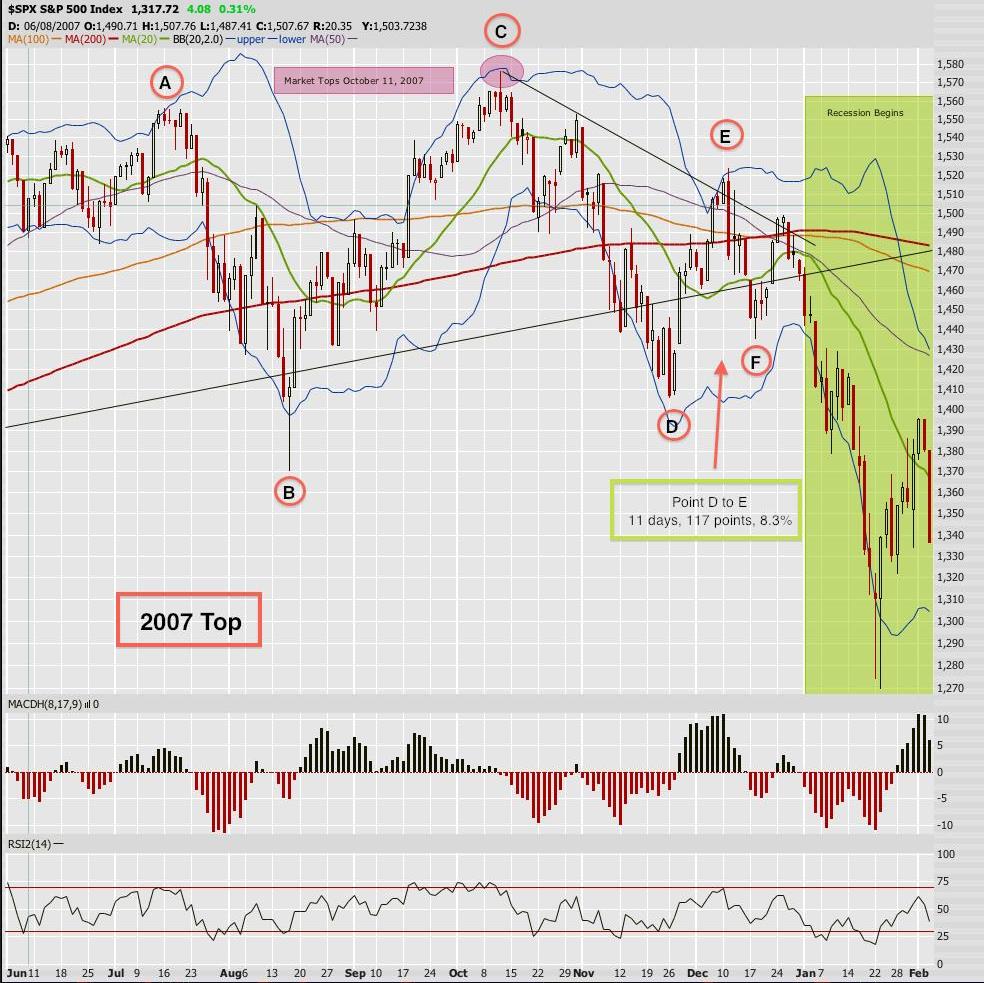Many posts will focus on macroeconomic data but this is a brief and interesting note about the current US stock market environment. Take a look at the charts which are intriguing. While it remains unclear whether or not the US will fall back into recession in the coming months, GDP for the first half of 2011 is likely to have been sub-2%. Historically, sub-2% year over year GDP gains has been a reasonable forecaster of coming recessions.
From Tony Pallotta of MacroStory.com
How An Equity Market Prices In Recession
Recently I compared the 2007 equity topping pattern to that of the current market. The premise being today as in 2007 the US economy is quite possibly entering economic recession. Long gone are the days of equity markets being forward looking as proven in 2007 when they peaked just two months before contraction began. A similar pattern is also playing out in the 10 year treasury.
I suspect a topping market is more a function of psychology and less technicals or macro data. The money making bull is slowly dying while the bears are eager for their turn to shine. The result of this clash of views and buying power is dictated more by emotional, whipsawing action where convictions in one's position and volatile price action make coexistence difficult if not impossible.
In the original post the question was "are we forming Point E." Well it appears Point E has in fact been formed and the pattern continues to play out almost text book. Some will argue in 2007 we were trading below the 200MA for example but I reiterate topping patterns may be more psychological and less technical in nature.


From Tony Pallotta of MacroStory.com
How An Equity Market Prices In Recession
Recently I compared the 2007 equity topping pattern to that of the current market. The premise being today as in 2007 the US economy is quite possibly entering economic recession. Long gone are the days of equity markets being forward looking as proven in 2007 when they peaked just two months before contraction began. A similar pattern is also playing out in the 10 year treasury.
I suspect a topping market is more a function of psychology and less technicals or macro data. The money making bull is slowly dying while the bears are eager for their turn to shine. The result of this clash of views and buying power is dictated more by emotional, whipsawing action where convictions in one's position and volatile price action make coexistence difficult if not impossible.
In the original post the question was "are we forming Point E." Well it appears Point E has in fact been formed and the pattern continues to play out almost text book. Some will argue in 2007 we were trading below the 200MA for example but I reiterate topping patterns may be more psychological and less technical in nature.
- In comparing the two patterns what's most interesting is that "last dash for yield" from Point D to E.
- In 2007 the SPX traded 117 points or 8.3% higher in 11 days while breaking the downtrend.
- In 2011 the SPX traded 98 points or 7.8% higher in 14 days while breaking the downtrend.
- The last piece of the puzzle would be Point F (an appropriate label) where markets attempt once last rally while the macro data finally confirms what many had feared, that this soft patch is anything but "transitory."
No comments:
Post a Comment